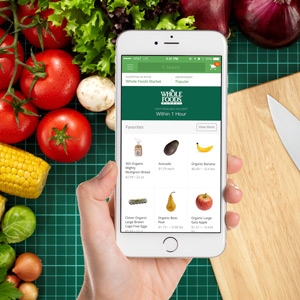retail
U.S. Consumers Warming To Digital Grocery Shopping
- by Sarah Mahoney @mahoney_sarah, April 29, 2015

When it comes to what’s for dinner, America still lags much of the world in its willingness to find digital solutions. But a new report from Nielsen says that between Millennials, in-store tech advances and such emerging delivery options as Instacart and Amazon, the future is closer than you might think.
“The connected commerce era has arrived,” says Patrick Dodd, president of Nielsen’s global retailer vertical, in the report. “Consumers are no longer shopping entirely online or offline; rather, they’re taking a blended approach, using whatever channel best suits their needs.”
The survey, based on response from 30,000 shoppers in 60 countries, finds that the willingness to use digital retail options in the future is highest in the developing markets in the Asia-Pacific, about 60% on average, and driven by denser urban areas, rapid smartphone adoption and higher concerns about food quality. Latin America is at about 60%, followed by Africa/Middle East regions, at 59%, North America at 52%, and Europe, at 45%. And 37% of consumers in Asia-Pacific are already ordering groceries online for home delivery, compared with only 12% in North America.
advertisement
advertisement
But focusing on e-commerce overlooks the many other ways that consumers are using to connect with supermarkets, such as online or mobile coupons (already used by 18% of shoppers worldwide); mobile shopping lists (15%); self-checkout lines (22%) and hand-held scanners (12%.) And about 12% are already ordering food online for in-store pickup, while 10% order online for curbside pickup.
For marketers, Dodd writes, the key is responding to product categories and occasions that offer the most potential for e-commerce. “Consumers are embracing the idea of buying certain packaged goods online, but some categories are simply better suited for e-commerce,” he writes. “Understanding what consumers are buying both on and offline allows you to prioritize digital initiatives and take action with the categories that drive in-store trip count and basket size.”
Stock-up categories, such as personal care and household products, are prime selections. Body wash, for example, is something 33% of respondents could see themselves ordering online, while products with any urgency are less likely, with just 13% saying they’d be likely to buy pain relievers online. Items that require inspection, such as vegetables, are also low on their online shopping list.
Price continues to be the primary motivator for grocer shoppers, and that’s especially true in North America, where 72% of respondents say it has driven them to switch stores, far more than convenience, which at 45% is the second most important factor.
But the report makes it clear that it’s important to look at grocery shopping as a complex, and to remember that people genuinely like it. Worldwide, 61% describe it as “an enjoyable and engaging experience.” And 57% describe it as a fun day out for the family.
The winners, he says, will be retailers who can put it all together in a way that’s fun, affordable, convenient and quality-driven. “At present, shoppers do all of the work putting the pieces together to arrive at their final purchase decision,” said Dodd. “In a competitive retail environment, retailers and manufacturers can add value and differentiation by providing digital tools to help consumers take control of their shopping experience while also increasing sales potential. Mobile in particular can tip the scales in favor of increased shopper control, empowering them to shape the shopping experience more than ever before.”



Interesting information! I second the need for brands to know what grocery categories consumers are buying/likely to buy online vs in person. Having this level of insight can definitely optimize the way we reach shoppers online. In my work I'm finding that Millennial moms are very comfortable buying routine supplies, such as baby's diapers (Diapers.com app is a mom's best friend), water, milk & juices from Whole Foods Market, as well as packaged items like cereals. When it comes to fresh fruit and veggies, and meat and seafood, I see more moms wanting to purchase those items in person.